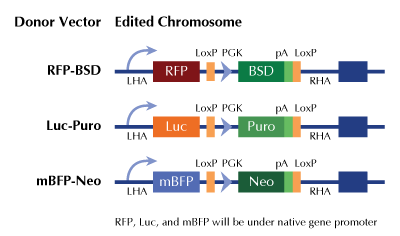p16INK4A (CDKN2A) Human Gene Knockout Kit (CRISPR)
CAT#: KN211784BN
CDKN2A - human gene knockout kit via CRISPR, HDR mediated
HDR-mediated knockout kit validation
CNY 12,260.00
CNY 3,710.00
CNY 1,999.00
CNY 2,700.00
CNY 1,800.00
CNY 4,180.00
Specifications
| Product Data | |
| Format | 2 gRNA vectors, 1 mBFP-Neo donor, 1 scramble control |
| Donor DNA | mBFP-Neo |
| Symbol | p16INK4A |
| Locus ID | 1029 |
| Kit Components |
KN211784G1, p16INK4A gRNA vector 1 in pCas-Guide CRISPR vector, Target Sequence: GCAGGTTCTTGGTGACCCTC KN211784G2, p16INK4A gRNA vector 2 in pCas-Guide CRISPR vector, Target Sequence: ACGAAAACCCTCACTCGCGG KN211784BN-D, donor DNA containing left and right homologous arms and mBFP-Neo functional cassette. pUC vector backbone in gray; Left arm sequence in blue; mBFP-Neo in green; Right arm in violet TTTTAAATAA TCTAGTTTGA AGAATGGAAG ACTTTCGACG AGGGGAGCCA GGAATAAAAT AAGGGGAATA GGGGAGCGGG GACGCGAGCA GCACCAGAAT CCGCGGGAGC GCGGCTGTTC CTGGTAGGGC CGTGTCAGGT GACGGATGTA GCTAGGGGGC GAGCTGCCTG GAGTTGCGTT CCAGGCGTCC GGCCCCTGGG CCGTCACCGC GGGGCGCCCG CGCTGAGGGT GGGAAGATGG TGGTGGGGGT GGGGGCGCAC ACAGGGCGGG AAAGTGGCGG TAGGCGGGAG GGAGAGGAAC GCGGGCCCTG AGCCGCCCGC GCGCGCGCCT CCCTACGGGC GCCTCCGGCA GCCCTTCCCG CGTGCGCAGG GCTCAGAGCC GTTCCGAGAT CTTGGAGGTC CGGGTGGGAG TGGGGGTGGG GTGGGGGTGG GGGTGAAGGT GGGGGGCGGG CGCGCTCAGG GAAGGCGGGT GCGCGCCTGC GGGGCGGAGA TGGGCAGGGG GCGGTGCGTG GGTCCCAGTC TGCAGTTAAG GGGGCAGGAG TGGCGCTGCT CACCTCTGGT GCCAAAGGGC GGCGCAGCGG CTGCCGAGCT CGGCCCTGGA CGGGGGAGTG GGCAGCGCCA GGGGCGCCCG CCGCTGTGGC CCTCGTGCTG ATGCTACTGA GGAGCCAGCG TCTAGGGCAG CAGCCGCTTC CTAGAAGACC AGGTAGGAAA GGCCCTCGAA AAGTCCGGGG CGCATTCGGC ACTTGTTTTG TTTGGTGTGA TTTCGTAAAC AGATAATTCG TCTCTAGCCC AGGCTAGGAG GAGGAGGAGA TAACCGCCGG TGGAGGCTTC CCCATTCGGG TTACAACGAC TTAGACATGT GGTTCTCGCA GTACCATTGA ACCTGGACCT CCCTTCACAC AGCCCCTCAA TCGTGGGAAA CTGAGGCGAA CAGAGCTTCT AAACCCACCT CAGAAGTCAG TGAGTCCCGA ATATCCTGGG TGGGAATGAC TAAGACACAC ACACACACAC ACACACACAC ACACACACAC ACACACACAC AGTAGGAAAG GTGTATTTCA AGCACACTTT CTTTCTCCTT GGGGAGAATT ATTGCTAACC ATCTAAGTTT TCTGGAGGCG GCCTTTTTTC TCCCCAGCCT CCCGGCGGGG TCACCCTCTC CCACCTTCCA GGAGAGTGGA GGACCCGTGA GATACGGGGCGE100003, scramble sequence in pCas-Guide vector |
| Disclaimer | These products are manufactured and supplied by OriGene under license from ERS. The kit is designed based on the best knowledge of CRISPR technology. The system has been functionally validated for knocking-in the cassette downstream the native promoter. The efficiency of the knock-out varies due to the nature of the biology and the complexity of the experimental process. |
| Reference Data | |
| RefSeq | NM_000077, NM_001195132, NM_058195, NM_058196, NM_058197, NM_001363763 |
| Synonyms | ARF; CDK4I; CDKN2; CMM2; INK4; INK4A; MLM; MTS-1; MTS1; P14; P14ARF; P16; P16-INK4A; P16INK4 |
| Summary | This gene generates several transcript variants which differ in their first exons. At least three alternatively spliced variants encoding distinct proteins have been reported, two of which encode structurally related isoforms known to function as inhibitors of CDK4 kinase. The remaining transcript includes an alternate first exon located 20 Kb upstream of the remainder of the gene; this transcript contains an alternate open reading frame (ARF) that specifies a protein which is structurally unrelated to the products of the other variants. This ARF product functions as a stabilizer of the tumor suppressor protein p53 as it can interact with, and sequester, the E3 ubiquitin-protein ligase MDM2, a protein responsible for the degradation of p53. In spite of the structural and functional differences, the CDK inhibitor isoforms and the ARF product encoded by this gene, through the regulatory roles of CDK4 and p53 in cell cycle G1 progression, share a common functionality in cell cycle G1 control. This gene is frequently mutated or deleted in a wide variety of tumors, and is known to be an important tumor suppressor gene. [provided by RefSeq, Sep 2012] |
Documents
| Product Manuals |
| FAQs |
Resources
| 基因表达相关资源 |
Other Versions
| SKU | Description | Size | Price |
|---|---|---|---|
| KN211784 | CDKN2A - human gene knockout kit via CRISPR, HDR mediated |
CNY 12,260.00 |
|
| KN211784LP | CDKN2A - human gene knockout kit via CRISPR, HDR mediated |
CNY 12,260.00 |
|
| KN211784RB | CDKN2A - human gene knockout kit via CRISPR, HDR mediated |
CNY 12,260.00 |
|
| KN411784 | CDKN2A - KN2.0, Human gene knockout kit via CRISPR, non-homology mediated. |
CNY 8,680.00 |
|
| GA100741 | CDKN2A CRISPRa kit - CRISPR gene activation of human cyclin dependent kinase inhibitor 2A |
CNY 12,255.00 |
其它p16INK4A产品


 United States
United States
 Germany
Germany
 Japan
Japan
 United Kingdom
United Kingdom
 China
China

